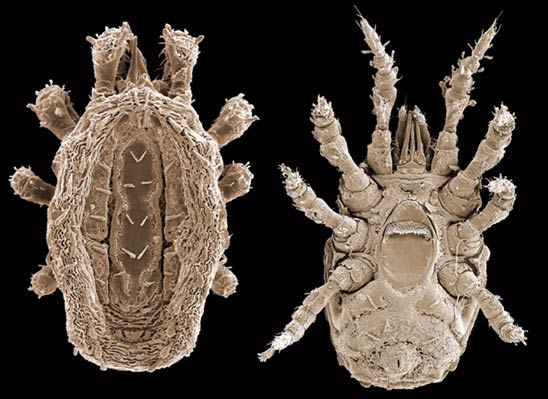Taxonomic Position
Cohort Uropodina
Subcohort Uropodiae
Superfamily
Polyaspidoidea Berlese
Polyaspididae Berlese
Polyaspis Berlese, Dipolyaspis Berlese, Calotrachys Berlese, Pollaspidella Berlese, Dyscritaspis Camin
Diagnostic characters:
-
Dense coating of cerotegument
-
Podonotal shield and free marginal seta (or small plates) and pygidial shields under cerotegument
-
<100 dorsal idiosomal setae
-
Scabellum and pedofossae absent.
-
Sternal setae (st1-4) on sterno-parapodal-peritrematal shield that encompasses the genital opening anteriorly and laterally
-
st5 usually on small latigynial shields (rarely fused to genital shield)
-
Anal opening on ventrianal shield with 5 circumanal setae.
-
Genital shield usually nude, entirely intercoxal, without anterior median process.
-
Legs I without ambulacra, coxae I enlarged, but subcylindrical and widely separated; trochanter I with 4 setae; tibia I with 4 (rarely 3) dorsal and 2 ventral setae; all genu with 4 dorsal setae; genu II with 4 lateral setae.
-
Chelicerae typically robust, elongate, with long snap-trap digits; corniculi elongate, bayonet-like.
-
Tectum with strong median process; hypostomal denticles in rows to either side of furrow.
-
Palp apotele 2-tined; palp genu with 4-5 setae, palp femur with 5 setae.
-
Tritosternal laciniae typically fused, highly divided; tritosternal wider than long, usually rectangular.
-
Male genital opening intercoxal, valves without setae; chelicerae not obviously modified for sperm transfer.

Similar taxa. The combination of elongate snapping chelcierae, bayonet corniculi, and fragmented dorsal shields serve to distinguish Polyaspis from all others.
Key to adult females of common genera of Polyaspidoidea
1. Idiosoma and mesogynal shield oval to subrectangular; marginal shield fragmented - 2
- Idiosoma pyriform, mesogynal shield trapezoidal; marginal shield entire - Trachytes
2. Genu IV with two ventral setae - 3
- Genu IV with one ventral seta - Polyaspinus (+ Uroseius)
3. Chelicerae and corniculi elongate, the latter reaching distal end of palpgenu - Polyaspis (+ Dyscritaspis)
- Chelicerae and corniculi not elongate - Dipolyaspis
Ecology.
Polyaspis mites are slow-moving, but effective predators that use their
elongate chelicerae to ‘snap-trap’ more active microarthropods such as
springtails. Polyaspis will also
feed on nematodes.
References
Ainscough,
BD. 1981. Uropodine studies. I. Suprageneric classification in the cohort
Uropodina Kramer, 1882 (Acari: Mesostigmata).
International Journal of Acarology 7:47-56.
Athias, F. 1976. Observations morphologiques sur Polyaspis patavinus Berlese 1881
(Acariens : Uropodides). 2. Morphologie et chètotaxie des appendices au cours du
dèveloppement postembryonnaire. Acarologia
18: 194-216.
Camin,
JH. 1953. A revision of the Cohort Trachytina Trägårdh, 1938, with the
description of Dyscritaspis whartoni, a new genus and species of
polyaspid mite from tree holes. Bulletin
of the Chicago Academy of Sciences 9: 335-385.
Camin,
JH. 1954. Polyaspis berlesei, a new species of trachytoid mite
(Mesostigmata: Polyaspidae). Bulletin of the Chicago
Academy of Sciences 10: 25-33.
Evans
EO and Till WM. 1979. Mesostigmatic mites of Britain and Ireland
(Chelicerata: Acari-Parasitiformes). An
introduction to their external morphology and classification. Transactions of the Zoological Society of
London 35 (2): 145-270.
Gilyarov MS & Bregatova NG (eds). 1977. Handbook for the Identification of Soil-inhabiting Mites, Mesostigmata. Zoological Institute of the Academy of Sciences: Petrograd [In Russian]
Karg W. 1989. Acari (Acarina), Milben Unterordnung Parasitiformes (Anactinotrichaeta) Uropodina Kramer, Schildkrötenmilben. Die Tierwelt Deutschlands 67: 1-203.
Krantz, GW
& Ainscough, B. 1990. Mesostigmata. pp. 583-665, in DL Dindal (ed) Soil Biology
Guide. John Wiley & Sons: Brisbane.